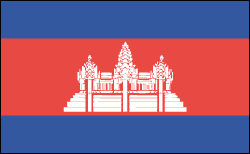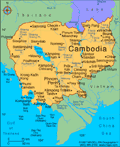Geography
Situated on the Indochinese peninsula, Cambodia is bordered by Thailand and Laos on the north and Vietnam on the east and south. The Gulf of Thailand is off the western coast. The size of Missouri, the country consists chiefly of a large alluvial plain ringed by mountains with the Mekong River to the east. The plain is centered around Lake Tonle Sap, which is a natural storage basin of the Mekong.
Government
Multiparty liberal democracy under a constitutional monarchy.
History
The area that is present-day Cambodia came under Khmer rule about 600, when the region was at the center of a vast empire that stretched over most of Southeast Asia. Under the Khmers, who were Hindus, a magnificent temple complex was constructed at Angkor. Buddhism was introduced in the 12th century during the rule of Jayavaram VII. However, the kingdom, then known as Kambuja, fell into decline after Jayavaram's reign and was nearly annihilated by Thai and Vietnamese invaders. Kambuja's power steadily diminished until 1863, when France colonized the region, joining Cambodia, Laos, and Vietnam into a single protectorate known as French Indochina.
The French quickly usurped all but ceremonial powers from the monarch, Norodom. When he died in 1904, the French passed over his sons and handed the throne to his brother, Sisowath. Sisowath and his son ruled until 1941, when Norodom Sihanouk was elevated to power. Sihanouk's coronation, along with the Japanese occupation during the war, worked to reinforce a sentiment among Cambodians that the region should be free from outside control. After World War II, Cambodians sought independence, but France was reluctant to part with its colony. Cambodia was granted independence within the French Union in 1949. But the French-Indochinese War provided an opportunity for Sihanouk to gain full military control of the country. He abdicated in 1955 in favor of his parents, remaining head of the government, and when his father died in 1960, Sihanouk became chief of state without returning to the throne. In 1963, he sought a guarantee of Cambodia's neutrality from all parties in the Vietnam War.
However, North Vietnamese and Vietcong troops had begun using eastern Cambodia as a safe haven from which to launch attacks into South Vietnam, making it increasingly difficult to stay out of the war. An indigenous Communist guerrilla movement known as the Khmer Rouge also began to put pressure on the government in Phnom Penh. On March 18, 1970, while Sihanouk was abroad, anti-Vietnamese riots broke out and Sihanouk was overthrown by Gen. Lon Nol. The Vietnam peace agreement of 1973 stipulated withdrawal of foreign forces from Cambodia, but fighting continued between Hanoi-backed insurgents and U.S.-supplied government troops.
Emergence of the Khmer Rouge
Combat climaxed in April 1975 when the Lon Nol regime was overthrown by Pol Pot, leader of the Khmer Rouge forces. The four years of nightmarish Khmer Rouge rule led to the state-sponsored extermination of citizens by its own government. Between 1 million and 2 million people were massacred on the “killing fields” of Cambodia or worked to death through forced labor. Pol Pot's radical vision of transforming the country into a Marxist agrarian society led to the virtual extermination of the country's professional and technical classes.
Pol Pot was ousted by Vietnamese forces on Jan. 8, 1979, and a new pro-Hanoi government led by Heng Samrin was installed. Pol Pot and 35,000 Khmer Rouge fighters fled into the hills of western Cambodia, where they were joined by forces loyal to the ousted Sihanouk in a guerrilla movement aimed at overthrowing the Heng Samrin government. The Vietnamese plan originally called for a withdrawal by early 1990 and a negotiated political settlement. The talks became protracted, however, and a UN agreement was not signed until 1992, when Sihanouk was appointed leader of an interim Supreme National Council convened to run the country until elections could be held in 1993.
Free elections in May 1993 saw the defeat of Heng Samrin's successor, Hun Sen, who refused to accept the outcome of the vote. In early July, Hun Sen took advantage of the country's political turmoil to depose Prince Norodom Ranariddh, the country's only popularly elected leader. Hun Sen later launched a brutal purge, executing more than 40 political opponents. Shortly after the July coup, the Khmer Rouge organized a show trial of their notorious leader, Pol Pot, who had not been seen by the West in more than two decades. He was sentenced to house arrest for his crimes against humanity. He died on April 15, 1998. In the July 1998 election, Hun Sen defeated opposition leaders Sam Rainsy and Prince Ranariddh, but the opposition parties accused him of voter fraud. Cambodia was able to regain its UN seat, lost nearly a year earlier as a result of Hun Sen's coup.
Cambodia Joins the World Trade Organization
Elections in July 2003 resulted in a stalemate—none of the parties won the two-thirds majority required to govern alone. Almost a year later, in June 2004, Ranariddh and Hun Sen agreed in June 2004 to form a coalition, with Hun Sen remaining as prime minister. In August, Cambodia's parliament ratified the country's entry into the World Trade Organization.
In March 2003, the UN and Cambodia announced that after five years they had finally agreed on a special tribunal to try senior Khmer Rouge officials on charges of genocide. Among those who were expected to stand trial were Kaing Guek Eav, alias Duch, who ran the notorious Tuol Sleng prison, and Ta Mok, alias the Butcher, who died in 2006 before his trial took place. In April 2005, the UN agreed to a funding arrangement for the tribunal.
King Norodom Sihanouk announced in Oct. 2004 that he had abdicated and selected his son, Prince Norodom Sihamoni, to succeed him. Prince Sihamoni, a ballet dancer and choreographer, lived in France and had kept a distance from Cambodian politics. Unlike his father, Sihamoni refrained from intervening in the country's politics, opting to reign as a spiritual and ceremonial figurehead.
In Feb. 2005, opposition leader Sam Rainsy was stripped of parliamentary immunity. He fled to France and was convicted in December in absentia of defaming Prime Minister Hun Sen. He received a royal pardon in 2006. Hun Sen has used defamation laws to crack down on political opponents and human rights groups, having at least seven activists and critics arrested in 2005 and 2006. Facing criticism from home and abroad, Hun Sen withdrew charges against four of the activists.
Khmer Rouge Officials Face Trial
Prosecutors trying senior Khmer Rouge officials made their first indictment in July 2007, charging Kaing Guek Eav, known as Duch, who ran the notorious Tuol Sleng prison where some 14,000 people were tortured and killed, with crimes against humanity. In September 2007, Nuon Chea, who was second-in-command to Pol Pot, was arrested and charged with war crimes. The first trial began in February 2009 in Phnom Penh, with Kaing Guek Eav as the defendant. He was convicted him of war crimes and crimes against humanity in July 2010 and sentenced 35 years in prison. He will only spend 19 years in prison, having already served 16 years.
In July 2008, Unesco, the cultural arm of the United Nations, designated the Preah Vihear temple, which sits on the Cambodian side of the Cambodian-Thai border, as a UN World Heritage Site. The move stirred nationalist emotions on both sides and fueled the tension between the countries. Both countries moved troops to disputed land near the temple. Skirmishing broke out between Cambodian and Thai troops in October 2008, and two Cambodian soldiers were killed.
Bloodshed at the border between Cambodia and Thailand near the site of the 11th-century Khmer temple complex continued in 2010, prompting the prime minister to call the exchanges of artillery and machine gun fire "a real war."
In September 2010, the UN-backed tribunal indicted four senior leaders of the Khmer Rouge on charges of genocide, war crimes, crimes against humanity, and murder. The defendants are Ieng Sary, former foreign minister; Ieng Thirith, former social welfare minister and the wife of Ieng Sary; Khieu Samphan, former head of state; and Nuon Chea, who was arrested in 2007. While the conviction of Duch was considered a milestone for the tribunal, the indictment of these figures is considered more significant considering the rank of the defendants. The trial began in November 2011. Ieng Sary died in March 2013 during his trial. The case against his wife, Ieng Thirith, had previously been suspended.
Because of the glacial pace of the proceedings, the case against the remaining defendants, Khieu Samphan and Nuon Chea, was divided into two trials. One covered the mass purge of Phnom Penh and other cities in an attempt to create an agrarian society; the other focuses on genocide. In August 2014, Khieu Samphan, 83, and Nuon Chea, 88, were found guilty of crimes against humanity and received a life sentence. The conviction and sentence seemed to be a disappointment for family members of victims given the age of the defendants and the uncertainty that the trial of genocide would be seen to completion.
Opposition Fares Well in Election
King Norodom Sihanouk, who abdicated in 2004, died in October 2012 in Beijing at age 89. The country observed a week of mourning following his death. Observers questioned if his successor, Sihamoni, would begin to immerse himself in the country's politics or continue to keep a distance from such matters.
The July 2013 election for seats in the National Assembly was unexpectedly close. Preliminary results had the governing Cambodian People’s Party taking 68 out of 123 seats, or 55%, and and the opposition Cambodia National Rescue Party, headed by Sam Rainsy, winning 55 seats—45%. Rainsy alleged that votes of his supporters had been suppressed. Rainsy and Prime Minister Hun Sen agreed to cooperate with an investigation by the National Election Committee. The committee ratified the election results in early September, confirming the preliminary results. Massive protests broke out in Phnom Penh over the decision and the Cambodia National Rescue Party boycotted the opening of parliament, which voted Hun Sen in to another five-year term. Protests against Hun Sen continued throughout 2013. Demonstrators called for his resignation and also demanded higher wages for garment workers. The protests turned violent in January 2014, when police killed five garment workers.
See also Encyclopedia: Cambodia
U.S. State Dept. Country Notes: Cambodia
National Institute of Statistics www.nis.gov.kh/ .










